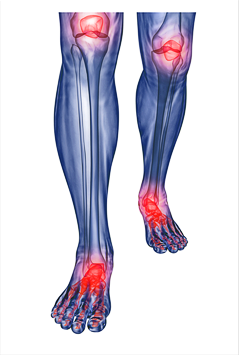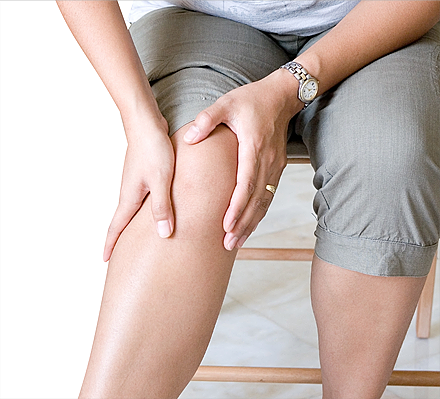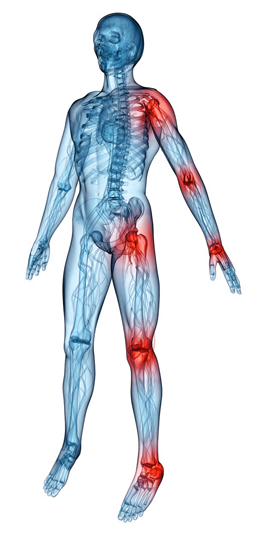Popular Articles
 Joints HurtIn This Article
Causes, symptoms, and possible diagnosis criteria for many of the physical health issues that cause hurt joints.
According to the CDC, arthritis - a cause of joint pain - is the leading cause of disability in the United States, affecting 21 million people. Yet it's not the only cause of joint pain. Joints may hurt as a result of damage. They may hurt as a result of inflammation. They may hurt as a result of a disease, and they may hurt as a result of aging. Before you can respond to your joint pain, it's important to figure out the cause of the pain, whether it is preventable, and how you can treat it effectively. What is a Hurt Joint?Before you can recognize the causes of joint pain, it's important to understand what the pain is and why your joint hurts in the first place. When your joints hurt, it usually means one of three separate issues:
There are dozens of different causes of joint discomfort, but joint pain is almost exclusively caused by at least one of the above issues that contribute to the experience of pain. Common Causes of Temporary Joint PainOften joint pain is temporary, and the result of overuse or damage. For example, if you spend a day out hiking in on a steep mountain, the physical exertion puts pressure on your joints (in this case, the joints in your knees and feet), causing them to experience stress and damage. As they try to heal, they become inflamed, and that results in joint pain. It's also possible to experience joint pain because of general joint stress. Sleeping incorrectly in a way that pulls on the joint may also cause pain. Joint pain can even be caused by changes in atmospheric pressure, such as during a thunderstorm. Temporary joint pain generally goes away within one or two days and is not necessarily indicative of a health problem. Spraining the JointAnother issue that may cause hurt joints is a joint sprain. Joint sprains generally last longer than one or two days and are usually caused by some type of direct injury. Sprains can be quite painful, and are broken down into three grades of severity:
Similarly, because both Grade II and Grade III can create immense pain and make it difficult to place pressure on the joint, they may be treated similarly and indistinguishable from each other without further testing. Joint sprains can cause a great deal of pain, but as long as they heal correctly and avoid experiencing further damage, most joints will eventually heal and the pain will subside. Age Related Damage That Causes Joints to HurtWithout proper nutrition, joints may struggle to regenerate. If you've put too much pressure on your joints over the course of your life, you may find that your joints have worn away and common movements will cause some mild but persistent pain. This is very common with athletes, hikers, and runners – all of whom put regular pressure on their joints but may not be nourishing them enough to help them regain their strength. By the time you've advanced in age, the joints may be too thin to avoid moving as smoothly and pain free as they were in your youth. If a joint was damaged with a Grade III strain in youth, it may also become re-aggravated as the joint wears down. It should be noted that aging itself does not necessarily cause joint pain, and even those athletes that put regular pressure on their joints throughout their life may not experience age related joint damage. What most people refer to as "Age related joint damage" is actually a condition known as osteoarthritis. Diseases that Cause Joint Pain
Often it's a combination of a variety of factors, including nutrition, hormones, and general damage. The joint becomes stiff, loses its lubrication, and becomes inflamed. Osteoarthritis is incredibly common, with some estimates indicating that over 20 million people currently experiencing some degree of osteoarthritis in the US alone. Osteoarthritis is also treatable and preventable, especially with proper nutrition and nourishment. Other diseases that may cause joint pain include:
With the exception of rheumatoid arthritis, most joint pain will be seen as a secondary symptom to something more serious. Rarely with disease-related joint pain will the joint pain be the primary concern, and often is not the most prominent symptom. Rheumatoid arthritis, however, is a joint related auto-immune disease. Those with this type of arthritis generally experience mild joint pain similar to osteoarthritis, but over time that joint pain will get worse without treatment. Potential Reasons Your Joint Hurts in Individual Joints
Why Your Finger Joints HurtThe finger joints are one of the most common places to experience joint pain. Now that men and women spend most of their day typing and on cell phones that involve repetitive motion, some degree of mild joint pain due to nothing more than overuse is becoming more and more common. Finger joints may also be prone to injury, especially during sports. Joint pain in the fingers is also a common symptom of both osteoarthritis and rheumatoid arthritis. In fact, rheumatoid arthritis – which affects most active joints in the body – generally starts at the fingers where the joints are more delicate. Why Your Knee Joints HurtWithin the knee, there are other joints that may cause joint pain. Like finger pain, pain in these joints is very common, and may simply be the result of inflammation as a result of regular use or stress. Runners, hikers, and those that are overweight often put pressure on their knee joints and causes the joints to swell. Both osteoarthritis and rheumatoid arthritis may also cause knee joint pain. The knees can also be prone to tendonitis. Tendonitis is not necessarily joint pain, but these tendons often surround the joint and the experience can resemble joint pain. Knees can also become overextended, especially during physical activities like basketball. This may cause a joint sprain that can range anywhere from Grade I to Grade III. Why Your Elbow Joint HurtsThe elbow joint is very important for movement, so when your elbow joint hurts it can be very disruptive for your ability to perform your daily activities. Elbow joint discomfort may be caused by a variety of issues. You may feel your joint hurt from simply sleeping on it incorrectly, as this puts long term pressure on the joint in a way that stretches it and leads to inflammation. Joint pain may also be caused by a sprain. It's slightly less common for elbow sprain to occur during athletic activities, but sprains may occur during an accident or a fall when you try to stop your fall with your hands. Bursitis may also cause hurt joints. It's caused by inflammation that leads to a sac of fluid building up between the joint ligament and the bone, which causes pressure and pain. Why Your Shoulder Joint HurtsLike all hurt joints, shoulder joint pain may be caused by osteoarthritis, rheumatoid arthritis, and traumatic injury or sprain. Bursitis is also a possibility. Another joint problem more unique to the shoulder is known as "frozen shoulder," or by its medical name, "adhesive capsulitis." Frozen shoulder is not specifically a joint pain problem, but can have a fairly pronounced effect on joint movement, and ultimately joint pain. Frozen shoulder occurs when the tissues that cover the joints swell and become inflamed. Since the joints of the shoulder are so important for movement, this inflammation can essentially "freeze" the shoulder and make it very difficult to make any shoulder motions. The inflammation can also restrict access to nutrients in the joints, which in turn inflames the joints and leads to further pain – pain that many people find debilitating. Frozen shoulder also lasts for a significant period of time, often between six months to three years. Frozen shoulder often completely recovers with treatment and physical therapy, but this extended recovery time can be problematic, especially with chronic pain. It's possible for a frozen shoulder to occur with no known cause. But some diseases increase risk factors, including heart disease, diabetes, and rheumatoid arthritis. Why Your Foot/Toe Joints HurtThe most common causes of joint pain in the feet are the same as those described above. However, there are 30 joints in the foot, and unlike the fingers or elbows, the feet are almost always receiving pressure from bodyweight. It's possible for something as small as a structural abnormality of your foot or the type of shoes you wear to put continued stress on your joints that leads to inflammation. That inflammation will often go away simply by keeping pressure off your foot. Twisting your ankle is also a very common athletic sprain, and can in some cases reach a Grade III sprain, which requires a great deal of recovery time and disuse of the affected ankle. The foot is also the most commonly affected site of gout. While gout can technically affect any joint, it is most common in the big toe and affects men more often than women. Gout is easily treatable, but treatment is necessary to prevent any permanent joint damage. Other Causes of Hurt JointsIn very rare cases, cancers, stroke, and birth defects can also cause joint pain, but in most of these cases, joint discomfort is a secondary symptom. Lyme disease, drug-induced arthritis, and hemarthrosis caused by hemophilia are also very rare reasons for hurt joints. When the joint pain is very mild and appears to be healing, it is usually not necessary to seek any type of treatment. But other types of hurt joints may be preventable or manageable with proper nutrition, medicine, and physical therapy. That's why it's very important to start improving the health of your joints early and seek treatment immediately if you are concerned about the health of your joints. Sourceshttp://www.cdc.gov/arthritis/ |
||||||||||||
| Next Article: How to Stop Arthritis |





 One of the most common pains in the human body is joint pain. Joint pain can be caused by a variety of conditions.
One of the most common pains in the human body is joint pain. Joint pain can be caused by a variety of conditions. Joint pain may also be caused by diseases. The most common disease – and one of the most common causes of joint pain – is osteoarthritis. Osteoarthritis is often thought to be age-related joint damage, but the truth is that osteoarthritis is far more complicated.
Joint pain may also be caused by diseases. The most common disease – and one of the most common causes of joint pain – is osteoarthritis. Osteoarthritis is often thought to be age-related joint damage, but the truth is that osteoarthritis is far more complicated. Joint pain can occur for a variety of reasons and can affect every type of joint. However, specific joints tend to have more common causes of joint pain than others. Below is a list of the most likely cause of joint pain depending on where the pain occurs.
Joint pain can occur for a variety of reasons and can affect every type of joint. However, specific joints tend to have more common causes of joint pain than others. Below is a list of the most likely cause of joint pain depending on where the pain occurs.